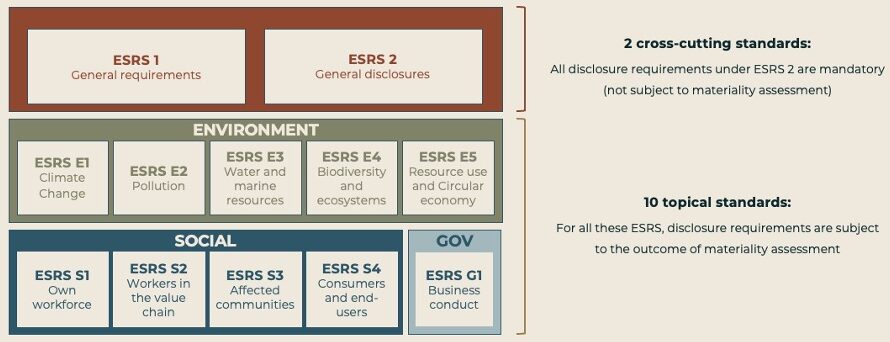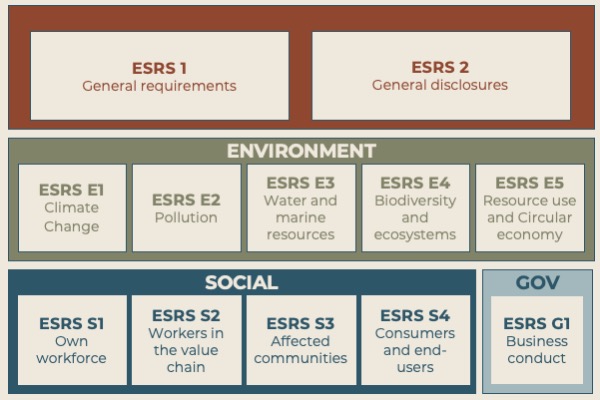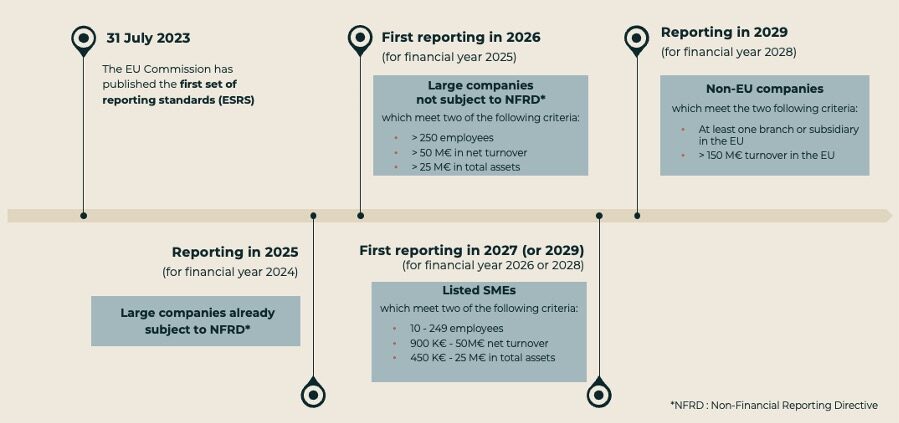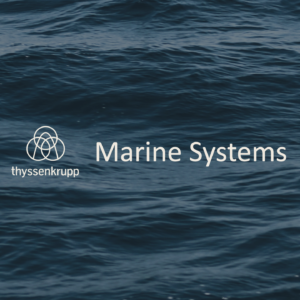
Baptiste Grüss
Consultant & Env. Policy Regulations Expert
A good understanding makes concrete and positive action possible
With the publication of the ESRS (European Sustainability Reporting Standards) by the EU Commission on 31 July, the CSRD is now a reality for 50,000 companies in Europe, that will have to write their first ESG report between 2025 and 2029, depending on their size and if they are listed or not.
By enlarging the scope of reporting companies, introducing double materiality, new common standards and including scope 3, CSRD creates a common reporting framework that improves the content and quality of sustainability information in the EU.
The Directive widens the scope of the Non-Financial Reporting Directive (NFRD) adopted in 2014, that only applies to large listed companies, banks and insurance companies with more than 500 employees, i.e. approximatively 11,600 companies in EU in 2021.
The CSRD applies to:
The CSRD won’t apply to:
The excluded firms can and are encouraged however use the developed standards voluntarily. At eolos, we do work with companies aligning to these standards although they are not requested to. This is a great journey to mobilise the teams and trigger improvements.
The Directive widens the scope of the Non-Financial Reporting Directive (NFRD) adopted in 2014, that only applies to large listed companies, banks and insurance companies with more than 500 employees, i.e. approximatively 11,600 companies in EU in 2021.
The CSRD applies to:
Large companies which meet 2 of the following criteria:
>250 employees
>50 M€ in net turnover
>25 M€ in total assets
Listed SMEs which meet two of the following criteria:
10 – 249 employees
900 K€ – 50M€ net turnover
450 K€ – 25 M€ in total assets
Non-EU companies which meet the two following criteria:
At least one branch or subsidiary in the EU
>150 M€ turnover in the EU
The CSRD won’t apply to:
Non-listed SMEs
Listed SMEs with financial assets on growth markets or multilateral trading facilities
Listed micro-enterprises which meet at least two of the following criteria:
10 and less employees
< 900K€ in net turnover
< 450K€ in total assets
The excluded firms can and are encouraged however use the developed standards voluntarily. At eolos, we do work with companies aligning to these standards although they are not requested to. This is a great journey to mobilise the teams and trigger improvements.
Regulatory compliance is just the first step towards a sustainable and economic future for your company. We translate the range of environmental regulations, integrating the specific industry targets and topics, as well as competitor and customer benchmarks. Check out our regulatory compliance page to discover how we can leverage the potential of your company
Materiality Assessment (Double Materiality)
Companies will have to report on how sustainability issues affect their business and development (“outside-in” perspective) and on the impact their activities have on people and the environment (“inside-out” perspective)
Standardisation
CSRD creates a common reporting framework that improves the content and quality of sustainability information: the European sustainability reporting standards (ESRS).
Materiality Assessment (Double Materiality)
Companies will have to report on how sustainability issues affect their business and development (“outside-in” perspective) and on the impact their activities have on people and the environment (“inside-out” perspective)
Standardisation
CSRD creates a common reporting framework that improves the content and quality of sustainability information: the European sustainability reporting standards (ESRS).
2 Cross-cutting
ESRS 1 General requirements
ESRS 2 General disclosures
5 Environmental:
ESRS E1 Climate change
ESRS E2 Pollution
ESRS E3 Water and marine resources
ESRS E4 Biodiversity and ecosystems
ESRS E5 Resource use and circular economy
4 Social:
ESRS S1 Own workforce
ESRS S2 Workers in the value chain
ESRS S3 Affected communities
ESRS S4 Consumers and end-users
1 Governance:
ESRS G1 Business conduct


ESG Indicators
Companies will be required to track and share their social and environmental impacts, as well as their governance practices. They will have to report on what they have put in place to contribute to the ecological transition with metrics.
Standards and digital format
The reports will have to respect precise standards, including in digital format, to facilitate the use and sharing of the information.
Audit
The reports will have to be audited and certified by an independent structure, which will verify the sincerity of the information and the presence of sustainability objectives.
Penalties
Penalties for infringements are not yet specified but will be defined by each Member State. However, the EU Commission indicated that they must be effective, proportionate and dissuasive.
An application in 4 stages
The directive will come into force in 2025 and its application will take place in 4 stages:
*Listed SMESs have a possibility to opt-out from the reporting requirement for a transitional period of 2 years


Consultant & Env. Policy Regulations Expert
A good understanding makes concrete and positive action possible

We embarked on a 6-month mission with thyssenkrupp Marine Systems. This journey began with a Double Materiality Assessment, a crucial step in identifying material ESG issues to be included in the inaugural thyssenkrupp Marine Systems sustainability report based on ESRS standards.

Over a 4-month sprint, we achieved AGEC Law compliance for Ariston through systematic regulatory analysis, collaboration with electrical system experts, and identification of knowledge gaps. We consolidated relevant information for compliant disclosure.

Over six months, we tackled our client’s locomotive reliability concerns by performing YTEOL analysis on three crucial systems. We offered customized recommendations that balanced economic advantages with essential technical and safety constraints.

Proud to announce we are serious about the climate emergency and committed to reach net zero emissions before 2050.
#UnitedNations #RacetoZero
Join us on our Race to Zero
eolos | engineering the future® and its logo is a registered trademark of eolos GmbH. All Rights Reserved
Design for Circularity and its logo is a registered trademark of eolos GmbH. All Rights Reserved
eolos GmbH – Rosenthaler Str. 33, 10178 Berlin, Germany – Amtsgericht Berlin Charlottenburg – HRB 207 570B
Don’t hesitate to directly schedule a meeting with an eolosian
Find our latest openings on LinkedIn or send us a spontaneous application via the form
By sending your name and E-mail you accept to be contacted by one of our experts.